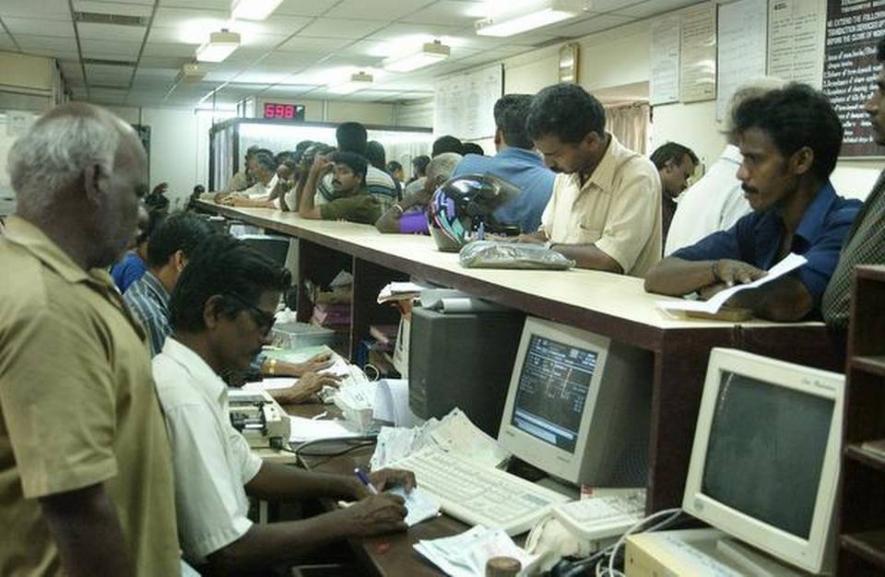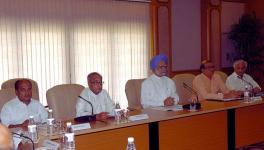IBA’s Performance-linked Wage Formula: Attempt to Absolve Bank Management

Image Courtesy: The Hindu
In October 2018, during the 11th bipartite wage settlement talks between the Indian Banks’ Association (IBA) and the United Forum of Bank Unions (UFBU), an umbrella organisation of bank workmen and officers’ unions, a new performance-linked wage formula was presented to the unions.
Under the new proposal, the Public Sector Banks (PSB) will be able to link the employees’ salaries with the financial performance of the bank.
The entire bank officers’ union as well as the workmen’s union had opposed the latest salary structure and the protest continued even when the talk resumed on June 21 – after a three month break for the 2019 Lok Sabha elections.
The proposal features grading of banks based on their performance in three categories: A, B and C. The two parameters – operating profits and Return on Assets (ROA) – will be used for computing the performance of a bank.
According to a Business Standard report, for Financial Year (FY) 2017-18, only two banks – Indian Bank and Vijaya Bank – would have qualified in the category A.
Also read: Public Sector Banks Reeling Under NPAs Post Huge Losses
According to the IBA, the introduction of performance matrix in deciding the salary of the employee will allow the loss-making public sector banks to reduce the burden of wages of employees. However, such an argument only holds water if it is applied to the management as well.
In a financial year 2018, when the nation’s largest lender, State Bank of India, wrote off ₹ 40,809 crore, its chairman Rajnish Kumar was paid around ₹ 29.5 crore in salary and allowances. In the same FY, the total amount in salary and allowances that was paid to its managing directors was ₹ 102.04 crore.
Another argument put forward is that burying of the industry-wide wage pact will incentivise the employees of the financially weak banks to perform better, which will eventually lead to higher net profits for the bank.
However, a scrutiny of the financial books of the banks will reveal that the net profit of the banks are majorly affected by the alarming increase in bad loans and Non-Performing Assets (NPAs) – responsibility of which lies with the bank management and the employees.
NewsClick spoke to Thomas Franco, General Secretary of All India Bank Officers’ Confederation (AIBOC). According to him, the proposal is an attempt to absolve the bank management and make bank employees to bear the brunt of the ill-intentioned decisions taken by the management.
“The IBA is planning to bring in a proposal that will affect the salaries of the employees in a drastic manner as 30% of it will depend on the performance of the banks. An employee’s salary must be based on the performance but here, the parameters of computing that performance must be the gross profit and the total business of the bank which includes deposits and advances,” he said.
He also added that this proposal is also in line with the tradition that has been followed by the private banks. In public banks, there is already an increase in “the outsourcing of the jobs to private contractors” who eventually don’t provide any social security to the workers. A performance-linked salary structure will only lead the banking industry to end up in the hands of the private firms in the long run, leaving the economic foundations of the nations exposed completely to market vulnerabilities.
Also read: The Push for Privatising Banks
It was on October 10, 1966 that the first ever sector-wise, pan-India bipartite settlement was signed which became “the hallmark of bargaining in the banking industry”. Subsequently, in the last five decades, nine such bipartite settlements, which include an industry-wide wage pact, have been signed.
However, after the ending of the 10th bipartite settlement in October 2017, the national bankers’ lobby took a significant departure from the tested practice by proposing a performance-linked salary structure for grade six and seven employees and wage revision based on the negotiations for employees belonging to other grades – from one to three – which was later extended up to grade five.
Last year, on December 21, a strike was launched by the AIBOC demanding “full and complete mandate for officers (Scale I to VII) wage revision in 11th bipartite settlement” among other things.
Currently, majority of the PSBs (15 out of 20) have rejected the variable salary component and conveyed their support for wage revision based on the negotiations.
However, a full mandate for wage negotiation for all officers from Scale I to Scale VII is yet to be given by the remaining five PSBs – State Bank of India, Bank of Baroda, Punjab National Bank, Union Bank of India, and Indian Bank – which has forced AIBOC and National Organisation of Bank Officers (NOBO) to not take part in the wage revision talks.
Also watch: Public Sector Banks in Serious Danger: Thomas Franco
Get the latest reports & analysis with people's perspective on Protests, movements & deep analytical videos, discussions of the current affairs in your Telegram app. Subscribe to NewsClick's Telegram channel & get Real-Time updates on stories, as they get published on our website.
























